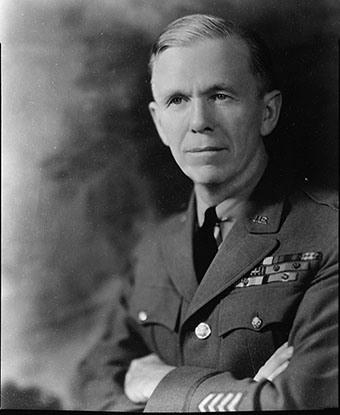Last updated: December 6, 2019
Person
George C. Marshall

Library of Congress
George Catlett Marshall Jr., American statesman and General of the Army, was born in Uniontown, Pennsylvania on December 31, 1880. A graduate of the Virginia Military Institute, Marshall rose to the prestigious positions of Chief of Staff of the US Army during World War II and two cabinet offices under President Truman: Secretary of State and Secretary of Defense. Before these incredible achievements, Marshall commanded Fort Moultrie as well as District I of the Civilian Conservation Corps for a brief time.
Marshall entered the U.S. Army commissioned as a second lieutenant in February 1902. He first saw combat in the largely forgotten Philippine-American War, a failed Filipino independence insurrection. Marshall then spent considerable time stateside, including studies and later instruction at Fort Leavenworth in Kansas.
Marshall served on General John J. Pershing’s staff during World War I, gaining valuable experience in managing wartime relationships with allies. He also assisted planning military operations. Marshall’s WWI service proved an amazing apprenticeship for his role in organizing victory during World War II.
Marshall spent his years between World War I and World War II rotating through various commands, principally in the United States but also in China. From July to October 1933, Marshall commanded Fort Moultrie where he received his promotion to colonel. His wife, Katherine Tupper Marshall, wrote of Fort Moultrie:
“Our quarters at Fort Moultrie were not a home, but a hotel. The house had been built by the Coast Artillery in its palmy days, but now the place was in bad repair....Colonel Marshall had his regiment, he was back with the troops - all was well with the world.”
Marshall particularly enjoyed continuing the work he had started at Fort Screven, his previous post, in the supervision of Civilian Conservation Corps camps. Proud of their work, Marshall seized opportunities to show them off to visitors. In September 1933, he invited officers and sailors from the visiting French cruiser D’Entrecasteaux to the dedication of a CCC camp near Georgetown, South Carolina, named Camp Lafayette in memory of the Frenchman who first landed in America near that spot in 1777.
“When the cars drove in the camp the band struck up the Marseillaise. George had given a holiday to the surrounding CCC Camps and as far as you could see lines of young American boys and French sailors stood at attention. It was a thrilling sight.”
Much to their disappointment, Colonel Marshall was quickly reassigned to the Illinois National Guard’s 33rd Division in November 1933. Colonel Marshall even wrote to Chief of Staff of the US Army General MacArthur to cancel the reassignment, describing his satisfaction with his command of Fort Moultrie.
Marshall’s arguably greatest contribution in a long life of public service was his integral role in organizing victory for the Allies in World War II as Army Chief of Staff. Together with his counterparts in the Navy and Army Air Force, he collaborated with the British to plan and execute military campaigns in Northern Africa, Sicily, Italy, and finally the cross-Channel invasion of France.
Marshall’s life of public service did not finish with victory over the Axis and the end of World War II. As Secretary of State, he led the American relief effort to rebuild and invest in European recovery. The European Recovery Program is better known as the Marshall Plan. Because of his leadership in this important work, Marshall became the only career US Army officer to ever receive the Nobel Peace Prize, which he was awarded in 1953. Poor health led to his resignation from the State Department, yet President Truman called upon him again as Secretary of Defense during the crisis of the Korean War.
After resigning as Defense Secretary, Marshall retired to his home, Dodona Manor, in Leesburg, Virginia. He died in 1959 and is interred at Arlington National Cemetery.
